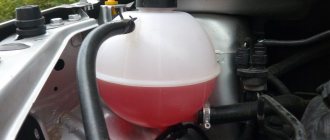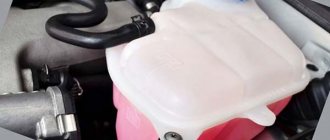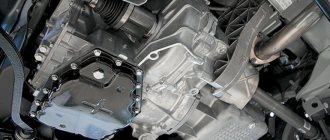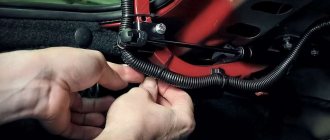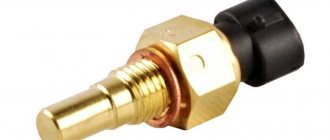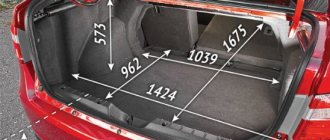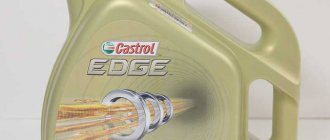September 2015 marked the start of production of a new model of the Lada family - Vesta. The car went on sale in November of the same year. The long-awaited event was preceded by numerous promotions and interviews with project leaders, in one of which Bo Andersson, President of AvtoVAZ OJSC, among other advantages of Lada Vesta, announced a record 5-year warranty for a new car for the domestic auto industry.
Such a step was supposed to demonstrate the company’s transition to a qualitatively new level, based on the use of new production technologies and the introduction of improved components. The same warranty period was expected for the Lada-Xray; previous models (Kalina, Priora, Granta and 4x4 SUV) continue to be sold with a standard warranty of 3 years or 100 thousand km.
For cars of the Lada Vesta family, the manufacturer…
...initially I planned to provide a longer and more extensive warranty than for Grant and Kalina. But ultimately it remained the same as its predecessors, and is 36 months or 100 thousand kilometers, whichever comes first. This means that if you actively use the car and can drive it 100 thousand in a year, your warranty will end there, even though 36 months have not yet passed. During the warranty period, the plant undertakes to eliminate any malfunctions at its own expense, if the need arises.
Shock absorption groups for trucks
Trucks, as well as cars, depending on their technical characteristics and type of purpose, belong to different depreciation groups, according to which their useful life is determined.
How does it depend on technical characteristics?
Depending on the type of truck and load capacity, freight vehicles are divided into the following depreciation groups:
- trucks equipped with gasoline and diesel engines with a carrying capacity of up to 3.5 tons are included in the third depreciation group;
- the fourth depreciation group includes general purpose trucks (dump trucks, tractors, vans, flatbed vehicles);
- The fifth depreciation group includes cars with diesel and gasoline engines with a carrying capacity of 3.5 to 12 tons, cars with a carrying capacity of over 12 tons, as well as truck tractors and specialized vehicles (hydraulic lift trucks, garbage trucks).
The composition of depreciation groups was also slightly changed by the new government decree.
Deadlines by classification
According to the accepted Classification of fixed assets, the useful life of trucks is determined by their belonging to a certain depreciation group.
- For the third depreciation group, the useful life is limited to 3-5 years.
- For the fourth depreciation group, the useful life period is limited to 5-7 years from the moment the vehicle is put into operation.
- Trucks belonging to the fifth group have a limited useful life of 7-10 years.
Knowledge of classes of cars and trucks, as well as new rules for accounting for the useful life of vehicles, will be useful not only in accounting, but also for private car owners.
For example, when determining the amount of taxation, insurance payments and determining the depreciation of a private car used in the work of organizations.
Didn't find the answer to your question? Find out how to solve exactly your problem - call right now:
Warranty cases, or when should I contact service?
The warranty for the Lada Vesta begins from the moment the new car is handed over to its first owner. It is only provided if the damage or malfunction is not the fault of the driver. Confirmation that the owner adhered to the operating criteria is the timely completion of technical inspection. Documents about this must be kept in order to be able to provide them if necessary and receive free repairs under warranty.
You can troubleshoot problems by contacting an official service center. A specialist must inspect the car and identify faults. Only on the basis of the expert’s conclusion will the official dealer make a decision on repair or replacement of components.
Some elements of the Vesta car have factory defects. These include sticking door handles, an external antenna falling off due to overtightening, non-functioning turn signals and heated glass. The manufacturer is aware of these shortcomings and carries out warranty replacement of these components without problems.
Oil getting into spark plug wells
As a result of work on the shortcomings, the VAZ 16-valve engine was made reliable. Now he doesn't cause any serious trouble. A plugless piston is installed, you can forget about the consequences of a broken timing belt.
But there was one fault remaining in the cylinder head. Owners periodically encounter it.
The head consists of 3 parts:
- Valve lid.
- Camshaft bearing housing.
- Main building.
All parts are joined together using sealant. Over time, the sealing layer is washed out, and oil begins to flow into the spark plug wells. This can be seen when replacing spark plugs if you remove the individual ignition coils. The problem is solved by disassembling the head and applying a new layer of sealant.
What documents are required to obtain a guarantee?
When contacting the service center with a problem, the vehicle owner must have the following documents with him:
- Warranty card;
- Service passport;
- Registration document;
- Driver's license (if necessary).
In addition, he must provide evidence that he has carried out a scheduled technical inspection and a separate inspection of the body elements, during which the presence or absence of corrosion or other defects in the paintwork is checked. It is necessary to undergo a body inspection, otherwise the warranty will not apply to it.
Related link:
The battery on the Lada Vesta is dead
Also, Lada Vesta owners need to know that if a malfunction occurs that makes it impossible to move the car, they have the right to call a tow truck, which will be paid for by the manufacturer if the warranty decision is positive.
How to use the guarantee
To take advantage of the Lada Vesta warranty, you need to bring your car to the service center of an official dealer with a set of papers.
— service ticket;
- service book;
— registration document;
- driver's license.
The owner provides transport for the necessary diagnostic work. All work is carried out by an engineer on site. If the car is not in working condition, it must be returned to the center. Employees will provide a tow truck or try to eliminate the cause on the spot.
If problems that arose during operation are confirmed, repair work is done at the expense of the organization.
If it is confirmed that the breakdown occurred as a result of the installation of low-quality spare parts, liquids or fuel, due to the fault of the owner, the center does not carry out work at its own expense.
Warranty periods for individual vehicle components and mechanisms
In addition to the warranty of the car itself, the factory provides special service life for its individual parts. This is due to the specifics of their work and the load they are exposed to during movement.
Special terms of the manufacturer’s obligations are provided for the following parts of the Lada Vesta:
| Car detail | Guarantee period |
| Body parts (through corrosion) | 6 years |
| Front strut bearings (supports) | 1 year or 35 thousand km |
| Accumulator battery | 2 years |
| Shock absorbers (front and rear) | 2 years or 40 thousand km |
| Clutch parts (discs, clutch release) | 3 years or 30 thousand km |
| Suspension parts (steering joints, bushings and stabilizer struts, ball joints, rubber and metal silent blocks, etc.) | 3 years or 50 thousand km |
| Exhaust system (mufflers, resonators, catalysts and sensors) | 1 year or 35 thousand km |
AvtoVAZ provides special conditions for cars equipped with gas equipment, such as Lada Vesta CNG. The warranty period for LPG, which is present on the car from the factory, is 2 years.
Consumable parts such as brake pads, gearbox and engine oil, brake fluid, wiper blades, fuses, filters, spark plugs, lamps and more are not guaranteed. They are changed by the owner independently if the need arises.
Vesta filter replacement under warranty
Regarding the third issue, the cabin filter was replaced. We recommend that you change the cabin filter at least once every six months. If you change it once a year, then blow it out with compressed air at least once every three to four months. The cost of a new cabin filter from an official dealer is about 900 rubles.
The dealership told me to call once a week to find out if the solution for the suspension came from the factory. The whole process took three hours and cost 250 rubles, which is the cost of a technical wash. We do not take into account the cost of the cabin filter, since this is our initiative.
Warranty obligations are valid for:
1. Timely and mandatory completion by the consumer of Scheduled vehicle maintenance (MOT) in the official LADA service center and inspection work to identify defects in paintwork and anti-corrosion coating of the car body
2. Availability of a “Service Book”, “Warranty Card” and compliance with their requirements (in case of loss or damage, you must urgently contact the official LADA service)
3. Compliance with the requirements of the “Operation Manual”
4. Making changes to the vehicle design, factory settings, parameters of electronic control units and software only in the official LADA service and approved by AVTOVAZ JSC
5. Compliance with the technology of vehicle repair and maintenance performed only in the official LADA service center
6. Timely elimination of other faults after they are detected in the official LADA service
7. Use of high-quality auto components, consumables and fuel
The final decision on troubleshooting the car is made by the official LADA service or JSC AVTOVAZ
Detailed information about the terms of the warranty is described in the warranty card
When can a manufacturer refuse a warranty?
The manufacturer of the Lada Vesta car clearly states the terms of the warranty and the reasons why it may refuse free service.
Failure may occur for one of the following reasons:
- Use of unsuitable (not recommended by the factory) lubricants and other consumables;
- Failure to eliminate (or untimely elimination) faults that were detected by the official service and led to other breakdowns;
- Carrying out repair work at non-certified service stations;
- Independent installation of any equipment, changes in software, any re-equipment of the vehicle by employees not authorized by AvtoVAZ;
- Mechanical damage to the body: dents, scratches, abrasions that arose during operation. The plant is not responsible for damage resulting from an accident, the actions of intruders, falling heavy objects, natural disasters, military operations, etc.;
- Exposure to the paintwork of chemicals: road surface reagents, bitumen stains, any substances of plant and animal origin;
- Damage caused by careless driving.
Related link:
Adjusting and bleeding the clutch on Lada Vesta.
The 6-year corrosion-free guarantee applies only to car body parts. The appearance of rust or arbitrary deformation on chassis parts, brackets and exhaust system elements is not subject to warranty.
Warranty repair of Lada cars
- If a breakdown occurs while driving, then the first thing you need to do is stop, turn off the car and visually inspect it to identify the cause. The best solution would be to evacuate the car directly to the dealership so that its employees do not have any unnecessary questions or complaints.
But the Lada dealership organizes a number of events aimed at correcting problems that have arisen right at the scene of the incident or to evacuate the car directly to a service center.
Reference. Evacuation will be carried out after detection of problems by a specialist at the expense of the service.
- If the breakdown did not occur while driving (the car stopped starting, the “Check Engine” light came on, etc.), then you should proceed in the same way as in the previous case.
There is no need to try to fix something yourself, or to drag the car to the service center with the help of another car and a cable. All this may lead to the dealer refusing to provide warranty repairs. Next, you need to check whether the warranty has expired based on the date or mileage of the car.
Conditions that must be met for the
- Timely mandatory maintenance at the services of an official dealer.
- It is mandatory to have a service book and a warranty card for inspection or repair.
- Compliance with the operating instructions.
- No changes were made to the design of the car, factory settings, parameters of electronic units, etc. not at the dealer's service.
- Repairs and maintenance were carried out only at the official Lada service center.
- Only high-quality gasoline and original consumables were used.
Where to contact?
It is necessary to contact only the official Lada service. After submitting all the necessary documents, you should hand over the car to confirm the damage.
Required documents
The transfer of the vehicle for repair must be accompanied by the presentation of all necessary documentation, namely:
- Warranty card.
- Service book.
- Vehicle Registration Certificate (VTC).
- If necessary, you may need a document that confirms the right to own the car provided to the service center.
Important! After handing over the car for service, the owner must be provided with documents confirming acceptance of the car. It must indicate: date, identified breakdowns, etc.
Deadlines
Several factors influence how long the repair will take. Initially, it is of particular importance to establish a deadline for eliminating problems in the contract, in the application, in the work order and other documents. In this case, repairs can last a maximum of 45 days.
If there was no agreement between the parties, then troubleshooting should be carried out as soon as possible. The service may issue a document to extend the vehicle repair time due to a lack of spare parts or others. Delaying repairs due to the listed reasons is considered illegal (Part 1, Article 20 of the Law).
The video below explains how to use the car warranty repair service:
Reviews from Lada Vesta car owners about the factory warranty
| Positive | Negative |
| I have a problem with the LED repeaters on the mirrors. They turned out to be leaky, and within a year they began to work poorly. When I contacted the service, to be honest, I thought that they wouldn’t change it, since the optics were not covered by the warranty. But the failure was recognized as covered by warranty, and both mirrors were replaced. True, we had to wait until the desired color was delivered. | After a year of use, severe scratches began to appear on the side glass of my Vesta. Apparently, the rubber seals fit too tightly to the glass and scratch it. When contacting the service, they said that this does not affect visibility and the integrity of the glass is not compromised. Even though there was a manufacturing defect, they refused to replace the glass. |
| I contacted the service center once. The stabilizer bushings creaked loudly. The specialists checked this by rocking the car on a special device, and immediately replaced it with new type bushings. I've been driving for the second month, nothing squeaks. | When purchasing a car, you carefully studied what the warranty covers. They promise 6 years on paintwork, but they forget to say that it is necessary to undergo a body inspection, separately from general maintenance. If it is not passed, the warranty is void. The service workers told me this in confidence, otherwise I wouldn’t have known. |
| My door handles started sticking about six months after purchase. During the next maintenance, the masters themselves noticed this and ordered me new pens for free. I was pleasantly surprised by the service! | I wanted to take the Lada Vesta, but when I found out how long the warranty was, I immediately changed my mind. Why only three years!? All competitors, for example Kia Rio, have been giving 5 years for a long time and working without breakdowns for the entire period and much more. AvtoVAZ’s quality is already not up to par, and the warranty is ridiculous! |
| It's a budget car, so there are a lot of minor problems with it. We have normal service at a certified station in Tyumen, and all complaints are considered. Recently they replaced my antenna free of charge, the mount was falling apart while moving. | After 30,000 km, a lot of problems emerged with Vesta. The AMT is humming, the handbrake cable does not hold, the pump is leaking, there are some strange knocks on the doors. At the office the station said that this was how it should be, they added oil (at my expense, by the way) and that’s it. What kind of guarantee is this? There are only problems with this car; it is still very far from foreign cars! |
Related link:
How to remove the dashboard on a Lada Vesta.
Reviews taken from the sites: https://Lada.online, https://www.zr.ru, https://vesta-site.ru, https://www.lada.ru.
LADA: course for change
About a year and a half ago, with the release of new Lada models and the arrival of a powerful designer and management, I began to follow and be interested in how the Lada brand has changed over the past 10 years, which I deliberately lost sight of, due to the fact that everything was clear to me about cars I didn’t consider vases, only as a last resort alternative in a tough low-cost airline.
In appearance, it seemed that the changes were beneficial, even the appearance of the car dealerships turned from dull semi-parking ones into standard car dealerships of any other brands: steel, glass, a spacious showroom, dedicated areas, service, general branding.
Oh miracle! - even cars for a test drive! (previously, Lada managers said that there was nothing to test there - Ladas and Ladas in Africa, so if you need a car, the cash desk is there, or don’t get in the way!).
There were sympathetic managers, girls at the entrance, in general, everything fell into a civilized direction. It would seem that you should be happy and grab these cars, because the quality has also increased (though along with the price).
The configurations have become similar to cars, and not to a cart from a supermarket (of course, not on all): now there are factory power windows, and not “cooperative” products, the radio tape recorder is now integrated into the interior, and is not bought in Eldorado (or right there in the showroom for three prices - otherwise they will be deprived of a non-existent guarantee), safety has improved - ABS in the base, airbags have appeared and, oh, Jah, finally an air conditioner, and whatever, working (!) adequately (!!) climate control (!!!) - in general, Ladas now have the whole set with which they are allowed into a decent automotive community.
But as usual, the details let us down.
conclusions
The warranty period for the Lada Vesta car is only 3 years or 100 thousand kilometers. Compared to Korean and European competitors, this is very little, since most of them offer a warranty of 5 years or 150 thousand km. A 6-year warranty is provided only for body parts that must not have undergone through corrosion during this period.
In most cases, the manufacturer carries out service repairs without any problems and makes the necessary replacement of spare parts. The car owner is only required to undergo scheduled maintenance on time and use oils and other technical fluids recommended by AvtoVAZ. Many of the shortcomings that new Lada cars suffer from are corrected by official representatives free of charge.
If you have been refused warranty repairs for your car
If you are denied warranty repairs for your car, partially or completely, this needs to be recorded
. For example, require an appropriate entry in the warranty card or write on their copy of the document which defect was not eliminated.
If the defect is truly a manufacturing defect, and you were denied warranty repairs, then this may be grounds for a refund for the product or an exchange. To determine the cause of the malfunction (the problem arose due to your fault or is it a manufacturing defect), you should contact an auto technical expert. After receiving a positive opinion from experts, we go to court.
Key words: universal article
Service for elements:
- six years for all body parts against erosive damage;
- three years and 50,000 kilometers for various spare parts;
- 24 months for components, in particular for batteries;
- one year or 35,000 kilometers for system elements and gas supply processing, bearings.
A car from an official dealer receives reliability and quality. If all rules of use and care are followed, the service center will solve all problems that arise within three years.
By the 30,000th mileage, Vesta had several questions for the technician under warranty. Not everything has been resolved yet.
LADA > Vesta
A brief summary of this entry for those who are limited in time or for whom it is simply excruciatingly painful to read many letters:
– This unit of our corporate park changed its location from Irkutsk to Chelyabinsk; – We have officially lost the warranty on this Vesta, but we are not losing hope for warranty repairs; “Rosgosstrakh turned out to be quite accommodating guys and repaired our cars.
And now the same thing in more detail.
I confess to you: I don’t know what to write about this car. Nothing particularly new happened during the entire time spent with her, as, for example, with the black Vesta - she obediently carries wherever asked and when asked in any weather and time of day. At the same time, he is not capricious at all. This makes me happy, but there’s nothing really to write about. However, no, there is something to write about, but for the most part the reason is given by people, not by the car.
I first became acquainted with Vesta when a year ago I drove a black Vesta with a “robot” from our state-owned fleet, so I somehow didn’t feel any special impressions when handing over the “blonde” Vesta to us, but the most noticeable ones were the “mechanics” and the smoothness of the ride... Surprisingly, in just over a year I have become slightly unaccustomed to the “mechanics” and stalled a couple of times while approaching a traffic light in the first hours of the trip =)). Secondly, after the Mazda6 (by the way, have time to buy, the auction is today), the smoothness of the ride was like a balm for the soul - yet the amazingly tuned suspension of the Mazda6 is not able to neutralize the excessively detailed transmission of the road condition to the riders from 19 wheels shod with “insulating tape”.
During the process of moving the car, I noticed a couple of features that were not noticeable when driving an “automatic” Vesta with cruise control - my legs were uncomfortable on long hauls. The right middle of the shin rests against the casing of the floor tunnel, after some time it begins to go numb, but the left one has, in fact, no support or platform for the foot - you ride, like in a GAZelle, holding your left knee with your palm so that it doesn’t hit the corner of the armrest and did not become numb while suspended... However, in the city this is generally unnoticeable and does not manifest itself in any way.
Otherwise, all impressions are identical to those I described a year ago. I won't repeat myself.
The car felt like it didn’t “pull” at first, so the first fill-ups were made with high-octane G-98 with a cleaning additive in it, and I drove along the highway in 3-4 gears so that the tachometer would show 3500-4000 rpm. So, towards Mariinsk, the car began to accelerate noticeably more confidently, and the exhaust pipe and the rear were covered with a terry coating of soot - apparently, they drove to me at the direction of the on-board computer, and, the bastard, for the sake of economy, it gives tips on how to make the engine work faster. By the way, upon arrival in Che, the pipe was “blown out”, the engine was “fried”, the clatter in the morning disappeared and it began to pull as it should.
Having arrived, I walked around the entire car and discovered in the underground trunk a leaking canister of Rosneft motor oil, which dissolved the existing “Shumka”, turning it into a gelatin-plasticine likeness. I had to peel it off, wash it with carb cleaner and glue it with a store-bought equivalent.
The one who carefully put the canister in the trunk, unfortunately, did not make sure that it was tight. We later got out of the situation by packing the bottle in a garbage bag (there it is, to the right of the wheel), but it was too late...
The bag had to be thrown away - the oil-soaked fabric simply burst under the pressure of the fire extinguisher
A sad sight...
This is how it turned out in the end. The narrow sheet on the shelf on the right is pasted over the scratched paint. It’s just that the sheet in the store was larger than needed, so the remnants were glued to the spare tire niche
We bought a new bag for the trunk, put everything in its place
I slightly modified the car to suit my needs - I put the “tee” on the socket and pushed it into the cavity of the instrument panel under the “stove” control unit, screwed the driver’s mat onto a self-tapping screw (there was a set left over from my personal Grant, where no problems were noticed with the mat running under the pedals).
The tee is glued with tape; the size of the niche allows you to push more massive splitters into it. But there is nothing to secure them there and connecting something on the go without a passenger is unrealistic
In addition to their intended purpose, indicator diodes of the splitter and charger plugs in the dark also illuminate the niche with cup holders
It was possible to install the screw only on the left - on the right in the place where the manufacturer of the mats suggests doing this; an air duct was laid under the carpet for the feet of the rear passengers. Don't poke holes through it...
To top it off, I removed the noise from the license plate on the trunk lid with "Shumka" stripes and supplemented the car's equipment with a "legacy" from Mazda6 - a jack purchased during the drive from the capital to the Urals, and a compressor. The standard jack turned out to be flimsy on surfaces other than ideal and was damaged, and the Matador Elite3 tires on standard rims that came from the factory consistently lost pressure in three of the four wheels: one was wrinkled - it was etching along the inner rim, the rest were caught by a screw. When changing shoes to a winter set, the problem with the wheels went away; at the same time, the wrinkled disk was straightened and thrown into the role of a “spare wheel”. By the way, the wheels from Irkutsk arrived tightly tightened.
Inheritance from Mazda6, will still serve
As I understand it, there are harsher tire fitters living in Irkutsk than in Chelyabinsk)))
And then we drove around, filled up with gasoline, washer fluid, and, as they say, we didn’t know any grief. The mileage of the next maintenance was imperceptibly dashed off. Before the service trip, I wrote down and photographed everything that I noticed was “wrong” with the car and that was covered by the warranty. I didn’t doubt my choice for a long time (but in vain), I went to my, so to speak, “alma mater”, to my ex-colleagues at Chelyabinsk-Lada. However, there is now “Asia-Auto Ust-Kamenogorsk, Chelyabinsk”, but this does not change the essence, because The composition of the persons of interest to us in this case is practically the same, and in the future in the text, for brevity, I will simply call them “Che-Lada.” And then interesting details emerged. In short, the warranty no longer applies to our car, because the AvtoVAZ computer does not have information about the completion of the 30,000 maintenance.
I had to put a little pressure, because there is a mark in the service book, and the maintenance has actually been completed, and the very fact that there is no information about this in the computer is a formality. Also, none of the defects was objectively dependent on mileage. The warranty engineer gave up, filmed the declared defects and sent a request to Togliatti. The response from Togliatti clearly hinted at the need for a visit to Buryat-Avto with a service book and work order...
A long analysis of the situation began in order to understand what was happening (and why). Half the country, from Tolyatti to Ulan-Ude, was raised to the ears. We found out the following: in Ulan-Ude the car came for maintenance with over-mileage, the mileage for natural reasons ended up in the AvtoVAZ system, and now they cannot send information about the maintenance - the system does not provide it.
Well, ok. Let's start to figure it out: the car arrived in Ulan-Ude with a mileage of 31,272 km (according to an order published a couple of blog entries ago). This is quite a lot, because the mileage allowance for TO-2 is from 29,500 km to 30,500 km (this is a whole thousand kilometers left - you can even get to any nearest official AvtoVAZ service station by transit). And this turns out to be an overmileage: 31,272–30,500 = 772 km... a bit much, to put it mildly. What about the mileage from Irkutsk to Ulan-Ude? Open the maps - 458 km. And here is an unexpected conclusion: Vesta left Irkutsk with a mileage of at least 300 km! Dry your oars, we've arrived...
The author of the idea has been found, but he has an alibi. What happened is not known for certain, but at least the situation as a whole is clear, and there is even a positive point (according to the publishing editor): we now have something to write on the blog. And not only on the blog, by the way! Since the communication with Togliatti ended with me being advised to write a letter to the head of the AvtoVAZ car service organization department stating that “we had a production need, as a result of which there was an overrun” with a request to restore the warranty. I had to write. I thought for a long time and wrote a letter in which I considered it inappropriate to ask for restoration and other “bells and whistles” (reasons with calculations above), and told everything as it is: so, they say, so, we understand everything, we admit everything, but we’re just asking explain how the overrun affected some parts that have certain inconsistencies with the qualities that were originally inherent in them, or repair them to us under warranty, because the warranty period for them has not expired, and the warranty card directly informs us of this possibility. I took a photo, printed it, prepared the required copies and sent the letter. What's the point of giving the "back" if the whole situation is clear in the palm of your hand? The AvtoVAZ support service gives interesting advice, but...
A description of all the shortcomings is a little lower, it will be more appropriate there))
This all went to Tolyatti
While the letter is traveling by Russian Post to Togliatti, we got down to the routine of TO-3 and comprehensive insurance.
Having assessed all the circumstances, I went for maintenance to other guys, to Saturn-2, and was very pleased with the visit. The maintenance was carried out as usual, they gave a list of outstanding service actions, one of them was even completed (re-routing the pipe to avoid chafing), since it is listed as mandatory. The others didn't, but I didn't insist. Based on the results of the maintenance, it turned out that the wear of the front brake discs exceeded the maximum 19.8 mm: right - 18.41 mm, left - 18.56 mm, the rest of the pads - 25%. We ordered the wheels, they have already arrived, we will change them soon.
TO-3 cost us 8315 rubles. Of these, 1810 are the cabin filter, which is not included in the regulations for mandatory replacement, and 2310 are the front pads, with removal and installation (not installed, because there were no discs in stock). That is, the TO-3 itself cost us 4195 rubles. - quite acceptable.
Set of materials for TO-3
Revision of the recall campaign: it was and is now
Condition of the underbody and suspension at the time of maintenance: having looked at the standard crankcase protection (essentially a boot), we were offered to buy protection
Condition of the air conditioner radiator (in the payment documents we are recommended to install a mesh in the bumper before it’s too late)
Chips on the rear bumper on the right and left (it is recommended to buy mud flaps)
Condition of brake discs and pads - replacement recommended
Brake fluid was replaced according to maintenance regulations
The breather is “sweating” with oil, and there is also a strange stain on the timing belt side of the engine. It was not possible to find out where it came from: the crankcase in that part was simply “sweating” evenly, without leaks
Set of documents for TO-3
“Secret” list of recalls for our car
Next, we decided to use the capabilities of the comprehensive insurance policy from RGS and claimed that the windshield - a chip and a crack from it + the rear bumper - bumped into something, damaged the paint and knocked out a piece of plastic.
I don’t understand why it turned out so badly...
Everything went quickly and without problems with the insurance company:
Day one: I announced by phone, came for inspection, received documents confirming the acceptance of the application.
Day two: I received a referral to the dealer via SMS in the morning (since the car is still under warranty in terms of the period and mileage).
Days three and four: I worked nonstop.
Day five: I arrived at the service center (it was on Friday), took photos again, assessed the scale of the disaster, took a time-out for the RGS verdict (from 2 to 7 days).
Days six and seven are days off.
Day eight: they called in the morning, offered to make an appointment for repairs, and gave me a range of days when it was convenient. I took time to think and coordinate the schedule. At the same time, we were pleased: the dealer had the windshield in stock. As soon as they invite us, we will immediately fix the brakes, replace the glass, and repaint the bumper, albeit with minor repairs at our expense (750 rubles - in the contract it turned out that our policy covers only repainting without calling the traffic cops, but repairs are paid) . And it is not yet clear whether the parking sensors will be affected - it beeps periodically in an open field, as if it sees an obstacle, I suspect the harness has knocked somewhere. This issue is being worked on and, I think, everything will be resolved soon, and in the second year we will buy comprehensive insurance without restrictions on body elements.
Day nine: I called and made an appointment for a specific date. The day before I simply stupidly forgot, I remembered late in the evening...
Total: if we remove from the “counting table” the days when I myself missed time and the weekends, we get 4 days in total for inspection, decision, direction and approval of the start of work. True, the body service has a certain workload at this time (winter has begun suddenly again for many, tinsmiths are under seasonal time pressure), but this is not critical at all. A good result compared to stories from the Internet...
One of the managers made an interesting misfire. It turns out that we have a unique electric train from AvtoVAZ)))))
While we were doing scheduled work, preparing for the next insurance season, and so on, our letter reached AvtoVAZ and they formalized a decision there, instructing the dealer (the same Che-Lada) to carry out an inspection on the items stated by me. More about this in this part.
The list of inconsistencies with the photo is the same one that was transferred to Togliatti:
1. Constantly present:
1.1. The symbols have disappeared from the factory identification plate on the right body pillar.
1.2. The chrome coating (amalgam) peeled off from the LADA trademark on the trunk lid with the letter D, and the processes of amalgam peeling began in the form of swelling of the coating on the remaining letters, as well as on the Vesta factory sign on the letter V.
1.3. The amalgam has peeled off from the chrome decorative elements of the front bumper: on the left - on the upper part from the inside along the edge; on the right - on the lower part and partially on the lower end, as well as a drop-shaped swelling on the upper edge at the bottom and on the upper part in the inner corner.
1.4. The turn signals in the side mirrors on the left and right fog up.
1.5. The indicator for the front passenger's seat belt not fastened is illuminated at full intensity; when inspecting it without the front cover of the lamp, a faint flickering of the LED indicator for the front passenger's airbag is also noticeable.
1.6. The paintwork on the inner surface of the right windshield washer nozzle has peeled off.
1.7. Water gets into the interior in the area of the mirrors on both doors after rain/car wash. Expressed by the appearance of water between the mirror trim and the front door trim.
1.8. Front door glass is scratched.
1.9. The paintwork on the trunk lid and rear bumper in the lower left and right corners of the trunk lid has been worn out.
2. Non-permanent deficiencies:
2.1. Spontaneous disengagement of the lumbar support of the driver's seat from the middle position.
I don’t know how to take a photo or make a video here to make it clear. Both extreme positions are uncomfortable for me, but the middle one is just right. But while driving, it “glitches” - it feels as if it falls out of the latch on the right and becomes skewed, and then after some time it snaps off on the left. At first I thought it seemed, but no, it manifests itself especially well on an icy “ridge” on the highway.
2.2. When starting the engine with the multimedia system turned on, the display backlight dims.
When the letter arrived at Che-Lada, the head of the warranty service called me. It was funny to listen to him - I knew the text of the letter that AvtoVAZ wrote to them, almost word for word, because... worked in this area. Awkward antics, they say, you need to come take photos, think, make a decision on your claims, but the wording of the official answers has not changed in all 5 years of my work - “invite so-and-so to check the quality of the specified car and draw up a technical condition inspection report.” Next comes a paragraph stating that the car needs to be removed from warranty, and the most interesting thing: to carry out diagnostics and eliminate all declared defects that fall under the warranty requirements. Essentially, a parting gift for the client and carte blanche in the hands of the warranty engineer to fix the problems and thereby get rid of the problematic client.
I offered to come right away and chat, there were a couple of free hours, and I was nearby. I came, I read... well, here it is, yes. The wording of the reason for the cancellation of the warranty: “Due to failure to pass the TO-2”, not a word about the untimeliness, but oh well, let’s say. Instructions for the warranty engineer - “In the event of manufacturing defects (in the absence of a cause-and-effect relationship with the failure to complete scheduled maintenance-2), eliminate these defects under the manufacturer’s warranty... In the event of defects arising due to improper operation of the vehicle, offer the consumer to eliminate them at your own expense."
Everything seems to be clear - the photos attached to the letter were quite informative, we were given the green light, but the guarantee was terminated. If there is no connection with the passage of maintenance and there are no violations on our part, it is a warranty case. What actually happened?
And it turned out to be a circus. With a conversation through the lip, with the incompetence of a warranty engineer, who almost for the first time saw the form of this notorious act of checking the quality of a car and has no idea what is in this car, grins addressed to the client about the very fact of handling in the existing conditions, grins about the very the fact of such concern for what is essentially a service car... It was both funny and disgusting. And all this against the backdrop of a total, pervasive mood to do anything, so as not to take on any responsibility. And I once learned to work from these people... screw... =(
Yes, guys, I really believe that I (former warranty engineer) understand better than you (current warranty engineers) why the plant needs you, why the consumer needs you, and what is actually going on. It was interesting to watch what was happening on this side. It’s an interesting feeling, by the way: you know that the warranty engineer has been given carte blanche. He can provide information to the factory confirming the description of the defect and, having promptly received the necessary parts for this order, replace the parts according to the list and fully satisfy the claim. Spend a couple of minutes to fully describe the reasons for replacing each of the parts and provide your company with compensation for this case, and yourself with a bonus, but the task in Che-Lad is different: “cover your ass” and sit quietly on the salary, without making unnecessary movements, and therefore the dialogue took place quite tensely. And no matter how funny it may be, I helped the warranty engineer understand the act of removing the car entrusted to me from warranty...
The surroundings in “Che-Lada”... There are only two photos, because... Among the public places there is a reception and a hall with a security post and a car wash. The client is not allowed to visit other places =(
By the way, these are not all the defects on the car. These are only those that are conditionally covered by the warranty.
List the rest? There are not many of them, but just right for holivar)))
— The bellows of the exhaust pipe has burnt out (we will replace it soon), a related problem, and perhaps the reason, is that the muffler hangers are torn from overstrain.
Here we need to clarify something - with a high-quality muffler suspension that preserves the geometry of the exhaust system, the probability that this will happen on its own due to normal engine operation is closer to zero than one. Most likely, in our case, we noticed the torn fastener too late. And now, in terms of mileage, we have already exceeded the exhaust warranty period.
The soot in the front part of the elastic insert is clearly visible, and in addition to the increased exhaust volume, there is an exhaust smell in the car
— The cup for the rubber stop of the engine cover fell off and was lost. A lost item is very difficult to recover. If he had stayed on heels, that would be a different story. The plant needs a probable reason why this happened, because. This is what will allow you to gain statistics and change your weak point in the future. What if the part is lost? A replacement can be made, but only for image reasons, which is a rarity these days, and for AvtoVAZ it’s completely nonsense.
Near supports - inserted independently, the middle right and far left are of greatest interest
All that was left of the “glass” was a trace where it stood...
This same “glass” ran away from our car in an unknown direction, the rest was removed and glued to cyanoacrylate before it’s too late
But this stop once stood in a regular place on a hairpin, but “lost its head,” and its notches fit perfectly into these places. New ones bought from Kalina for 20 rubles. little thing at the car market
Additional stops raised the front part of the cover, and it no longer rubs against the breather pipe
— The hood stop falls out of the latch. New cars have the same part - since there is no working solution to the problem, then there is nothing to present, although the situation with it is dangerous. Just look, the hood will hit you on the back if you move carelessly...
— Poor reception of the radio antenna. Noises and rustling begin three times faster than what happens in a Mazda6 or even in a Grant (with a standard antenna, by the way). But it works...
— The standard jack is “plasticine.” Well, yes, of course, this is not an integral part of the car, and it is designed for flat, hard areas, and not for work on the side of the road, and it doesn’t matter that its load capacity is only 800 kg, but if you look into the question, then this is also a warranty case in some options. But you first need to convince the warranty engineer to get to the bottom of the issue, look into the coding of the defect, determine what’s wrong with the jack, write to the factory... And this, in essence, is the client teaching the warranty engineer how to act in non-standard situations and who to call so that this replacement is successful. Do I need it?
The jack has no other damage
As a finale, a short lyrical digression from the series “It’s a shame for the state.” Not all people who occupy their workplace understand the purpose for which they occupy it. The worst thing is if the initially conceived goal is replaced by personal motives - this almost always stops the professional growth of such a “specialist”. Essentially, the warranty engineer is the eyes and ears of the plant. This is the person who is the first to protect the reputation of the plant in the eyes of the consumer and transmits information to the plant about the presence and nature of defects in manufactured products. Without good communication between the on-site engineer and the defect analysis function at the plant, the warranty engineer position is useless. It's just another extra unit to feed. The presence of feedback helps to actually improve products and reduce the number of defects. But the twice-native Volzhsky Automobile Plant has a problem with these connections, because No one teaches this motivation. Nobody gives the consumer an understanding of what a guarantee is and why it is needed. As a result, we get what we have: two warring groups - customers and dealer employees. And everyone has their own truth.
Best regards, Alexey Antropoff
PS Briefly in the next episode:
– We’ll tell you how the dialogue with AvtoVAZ ended; “We’ll show you what was repaired under comprehensive insurance, and what we had to fix at our own expense in order to extend the policy for another year without restrictions.”
First symptoms
At about the fifth thousand kilometers, the car periodically began to shift into first gear not very well. Everything worked as normal, but the switching was not smooth and was accompanied by vibration.
By the seventh thousand kilometers, the frequency of problems increased. The vibrations increased. Sometimes there was even a knocking sound under the bottom (as it turned out later, it was the muffler knocking). Most often, these problems arose in warm weather, after the car had completely warmed up.
The easiest way to make the car twitch was this:
- Drive around town to let the car warm up
- Stopped in traffic
- Take your foot off the brake pedal (you can even press the gas a little)
- A couple of seconds after starting to move, press the brake
- Enjoying the indescribable sounds and twitching of the car
If you set off with a sharper press of the gas, then at first you managed to avoid this jerking. But by the eighth thousand kilometers, this stopped helping.
It was no longer possible to drive like this, so I turned to our dealer, the Forsazh car dealership (on Bukharestskaya).
Why do you need a service book?
A service book is a way to record all your actions; it is a kind of logbook. And this makes sense:
Reference material - technical inspection coupons in the title indicate the approximate mileage of the car at which you should contact a mechanic. Remember, these are not simple numbers, and every part in the car has a resource. The numbers written in the book are not a “joke”, but a recommendation from AvtoVAZ designers and manufacturers. Safety net - any failure of warranty repairs may initiate legal proceedings on your part. If you are sure that a production error occurred, you should give the matter resonance - somewhere the same people as you are using cars from this batch. Your Selling Advantage - When the time comes to sell your car, potential buyers will have a lot of doubts and questions about the car. When you give the buyer a service book to read, with all the marks, it will be a signal to him that the seller took good care of the car and was not lazy to contact those regarding warranty issues. When you think about a guarantee, open the first pages of this book - you should rely on this information.


